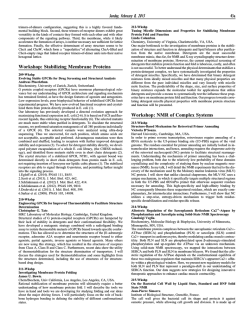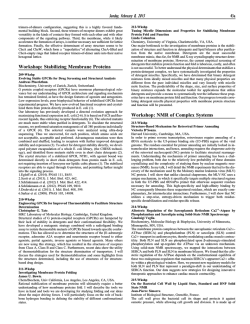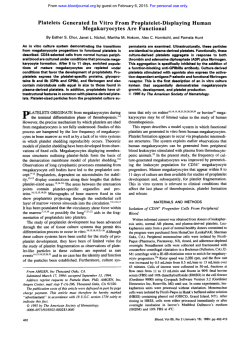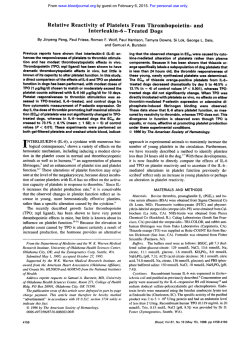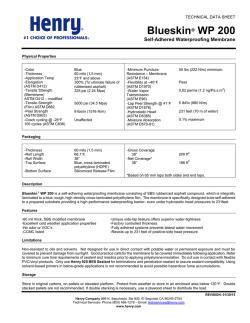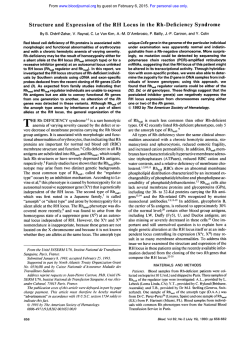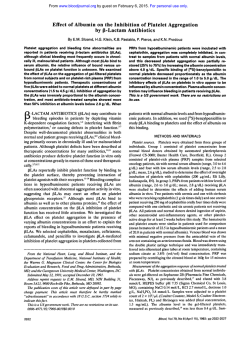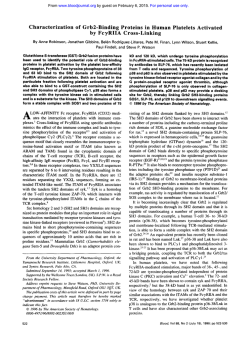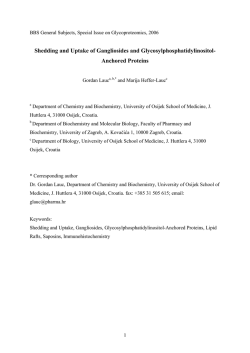
Alpha-Granule Membrane Mirrors the Platelet Plasma
From www.bloodjournal.org by guest on February 6, 2015. For personal use only. Alpha-Granule Membrane Mirrors the Platelet Plasma Membrane and Contains the Glycoproteins Ib, IX, and V By Gaetan Berger, Jean-Marc Mass& and Elisabeth M. Cramer We have recently shown thatseveral components from the platelet plasma membrane were also present at different rates in the alpha-granule membrane. This is the case for the glycoprotein (GP) Ilb-llla (CD41).CD36,CD9, PECAMI, and Rap1b. while theGPb-IX-V complex wasconsidered t o subcelescape the rule. In this investigation, we studied the lular localization of GPlb, GPIX, and GPV in the restingplatelets of normalsubjects, patients with Bernard-Soulier syndrome, patients with Gray platelet syndrome, and human cultured megakaryocytes. Ultra-thin sectionsof the cells were labeled with antibodies directed against glycocalicin, GPIb, GPIX, and GPV. We have shown thata significant and reproducible labelingfor the three GPs was associated with the alpha-granule membrane, accounting for approximately 10% of the total labeling. Furthermore, GPlb labeling appears colocalized with its alpha-granule-associated ligand, von Willebrand factor (vWF). After thrombin activation, vWF remained close to the limiting membrane ofthe open canalicu- lar system (OCS), suggesting an early association of both receptor and ligand. Plasma membrane and alpha-granule labeling was virtuallyabsent from theBernard-Soulier platelets (characterized by a GPlb deficiency), thus proving the specificity of the reaction. In Gray platelets (storage granule deficiency syndrome), the smallresidual alpha-granules were also occasionally labeled forGPlb, GPIX, and GPV. Cultured megakaryocytes that displayed the classical GPlb distribution, eg, demarcation and plasma membranes, exhibited also a discrete labelingassociated t o t halpha-granules. e In conclusion, this study showsthat, evenly for these three GPs, the alpha-granule membrane mirrors theplasma membrane composition. This might occur through an endocytotic process affecting each plasma membrane protein t o a different extent and could have a physiologic relevance in further presentation of a receptor bound t o i t alpha-granule s ligand t o t h eplatelet surface. 0 1996 by The American Societyof Hematology. P NaCl, 5 mmoVL glucose, pH 7.4) containing 3.5 mg/mL bovine serum albumin (Sigma Chemical CO,St Louis, MO). The washed platelets were resuspended and fixed with 1 % glutaraldehyde (Ladd Research Inc, Burlington, UK) in 0.1 mom phosphate buffer. Megakaryocytes used in the electron microscopic study were grown in liquid culture from bone marrow precursors obtained from normal adult graft donors, as previously described? LATELET alpha-granules represent a secretory compartment that releases its content after appropriate stimulation. They contain a wide variety of coagulation and adhesive proteins involved in hemostatic mechanisms.*They are formed during megakaryocyte maturation,’ where they arise by a double mechanism: endogenous synthesis and endocytosis of plasmatic proteins.”6 Furthermore, in recent studies, we have demonstrated that several plasma membrane receptors are also present in the alpha-granule limiting membrane. These receptors include glycoprotein (GP) IIb-IIIa, the fibrinogen receptor’; CD36, the thrombospondin and collagen receptor*;CD9; PECAM19;and Raplb, a guanosine triphosphate (GTP)-binding protein.’” Therefore, most of the studied proteins seemed to follow the rule, except the GPIb-IXV complex, which was considered until now to be restricted to the plasma membrane, possibly because of its cytoskeletal association.” In this study, we have tried to document this statement using an immunoelectron microscopic approach performed on normal andpathologic platelets and megakaryocytes. We have been able to demonstrate that small amounts of GPIb, GPIX, and GPV are associated with the alphagranule membrane. The presence of numerous plasma membrane receptors on the alpha-granule membrane suggests that the endocytic process that directs plasmatic proteins into the alpha-granule also affects a large pattern of plasma membrane receptors, although to a different extent. Antibodies Different antibodies against glycocalicin, GPIb, GPIX, and GPV were used for immunoelectron microscopy study. An anti-human GPIb monoclonal mouse antibody purchased from Dakopatts (Glostmp, Denmark) was used at 11100 dilution. An anti-human glycocalicin and GPV polyclonal rabbit antibodies, provided by Dr Michael Berndt, Prahran, A~stralia,’~.’~ were used, respectively, at 10 p g h L and 30 &mL.An anti-human GPIX, provided by Dr Kenneth Clemetson, Bern, Switzerland, was used at 30 pg/mL. An anti-human GPIX monoclonal antibody, provided by Dr Michael Berndt,16wasused at 30 pg/mL. For double immunolabeling, an anti-human P-selectin,” provided by Dr Michael Berndt, andan anti-human von Willebrand factor (vWF) purchased from Cappel Laboratory (Downington, PA) were used, respectively, at 30 pg/ mLand 1/50 dilution. Gold-conjugated (10 and15 nm) protein A purchased from the Department of Cell Biology, University of Utrecht (Utrecht, The Netherlands) were used, respectively, at 1/80 and1/35 dilutions. Characterization of the Poiyclonal Antibodies The specificities of the polyclonal antibodies were assayed by Western blotting of platelet lysate. Briefly, washed PRP was solubilized by MATERIALS AND METHODS Cells Platelet samples were taken from normal healthy volunteers, from a patient with Bernard-Soulier syndrome,’* and from a patient with Gray platelet syndrome.” Blood samples were harvested by venipuncture into plastic tubes containing ACD-C buffer (6.8 mmol/L citric acid, 11.2 mmoVL trisodium citrate, 24 mmoVL glucose, pH 4.2). The platelet-rich plasma ( P m ) was obtained by centrifugation for 10 minutes at 180g and 22°C.The isolated platelets were obtained by centrifugation of PRP for IO minutes at 1,100g and22°C and washed three times with Tyrode buffer (36 mmol/L citric acid, 5 mmol/L KCI, 2 mmol/L CaC12, 1 mmol/L MgC12, 103 mmol/L Blood, Vol 87,No 4 (February 15). 1996: pp 1385-1395 From INSERM (191, Hdpital Henri Mondor, Crkteil, France. Submitted March 20, 1995; accepted September 15, 1995. Supported in part by I’Association pour la Recherche contre le Cancer (ARC) and la Fondation pour laRecherche Medicab (FRM). Address reprint requests to Dr Elisabeth M. Cramer, INSERM U91, Hapita1 Henri Mondor. 94010 Crkteil, France. The publication costs of this article were defrayed in part by page charge payment. This article must therefore be hereby marked “advertisement” in accordance with 18 U.S.C. section 1734 solely to indicate this fact. 0 1996 by The American Society of Hematology. 0006-4971/96/8704-0004$3.00/0 1385 From www.bloodjournal.org by guest on February 6, 2015. For personal use only. BERGER, MAS&, '* AND CRAMER . . . Fig 1. (A and B) lmmunogold localization of GPlb with a monoclonal antibody on thin frozen sections of restingplatelets. lmmunolabeling is found t o be associated with the plasma membrane (pm) and open canalicular system (ocs).Some gold particles are also associated with thealpha-granule (a) membrane. whilemitochondria(m) are devoid of labeling. Bars, 250 nm. n 45 Fig 2. Biochemical characterization of the polyclonal antibodiesused in this studyby Western blotting of plateletlysates. (A) The anti-glycocalicin antibody recognizes a unique protein of approximately 145 kD molecular weight. (B) The anti-GPV antibody recognizes a protein of approximately 80 kD molecu(C) the anti-GPIX antibody recognizes lar weight, and a major protein of approximately 22 kD molecular weight. koa 80 kDa 22 kDa U From www.bloodjournal.org by guest on February 6, 2015. For personal use only. GPh, IX, V IN PLATELET ALPHA-GRANULES 1387 .. Fig 3. (A) lmmunogold localization of GPlb on thin frozen sections of resting platelets with the polyclonal anti-glycocalicin antibody. A strong labeling is observed to be associatedwith the plasma membrane(pm) and alpha-granules(al. (B) Double immunolabelingusing different sizes of gold particles (for P-selectin: 15 nm, arrows; glycocalicin: 10 nm, arrowheads) allows identification of labeled granules fa) as alphagranules, while mitochondria (m) are devoid of labeling. (inset) The same results are obtained with a double immunolabeling using anti-vWF (15 nm, arrows) and anti-glycocalicin(10 nm, arrowheads). Bars, 250 nm. the addition of 2% sodium dodecyl sulfate (SDS) and 1 mmoVL EDTA and separated on SDS-polyacrylamide gel electrophoresis (PAGE) with or without a reducing condition with 5% 2-p-mercaptoethanol. using a 7% resolving gel and 3% stacking gel. Gels were electroblotted on niwcellulose filtermembrane by semidrytransfer. The nonspecific binding was blockedin 5% low fat powder milk, and membranes were probed with polyclonal antibodiesfor 1 hour at m m temperature. The labeled proteins were revealed after incubation with sheep anti-rabbit immunoglobulins bound to peroxidase. Electron Microscopy Normal platelets and megakaryocytes were prepared for immunoelectron microscopy as follows: they were fixed in 1% glutaralde- hyde in 0.1 mol/L phosphate buffer, pH 7.4, for 1 hour at 22°C. washed three times with the same buffer, embedded in sucrose, and freezed in liquid nitrogen.'* Pathologic platelets were also embedded in glycol methacrylate according to the method described by Leduc and Bernhard'"; this technique permitted a more lasting storage for precious samples. Then, the immunochemical reactions wereperformed on thin sections collected on copper grids according to the method of Slot et al.'x Briefly, the sections were labeled by a first incubation with the antibodies diluted in phosphate-buffered saline (PBS) containing I % bovine serum albumin (Sigma) for 20 minutes at 22°C. washed, and then incubated with protein A-gold ( I O nm) for 20 minutes at room temperature. The sections were counterstained with 2% uranyl acetate, pH 7, and methyl cellulose uranyl. From www.bloodjournal.org by guest on February 6, 2015. For personal use only. 1388 BERGER, MAS&, AND CRAMER Fig 4. lmmunolocalization of GPIX (A) and GPV (B) with polyclonal antibodieson thin frozen sections of resting platelets. As expected for these GPlb-associated proteins, immunolabeling is foundto beassociated with the plasma membrane (pm), the open canalicular system (ocs) membrane, and also the alpha-granule membrane (a), while mitochondria(m) are devoid of labeling. For GPIX, the same results are obtained using a monoclonal anti-GPIX instead of the polyclonal antibody (A, inset). Bars, 250 nm. From www.bloodjournal.org by guest on February 6, 2015. For personal use only. 1389 GPIB, IX, V IN PLATELET ALPHA-GRANULES For double immunolabeling,a short time fixation with 1% glutaraldehyde in phospate buffer was realized after the incubation with the gold conjugate, and a second round of labeling with the second antibody was realized usinga different size of gold particle protein A conjugate. Samples were observed on a Philips 450 CM 10 electron microscope. Quantitative Estimation Membrane labeling intensity was evaluated by counting the gold particles per micrometer of membrane. The alpha-granule pool was with thealphaquantified by countingthegoldbeadsassociated granule membrane on one hand and the plasma membrane on the other: the ratio of intracellular versus plasma membrane pool per equatorial platelet section was calculated. RESULTS Resting Platelets Immunolocalization of GPIb. To ensure the specificity of the observed immunolabeling reaction, a monoclonal antibody against GPIb was used as a first instance. Immunolabeling on thin sections allows marking of plasma membrane proteins as well as intracellular proteins. In this experiment, labeling for GPIb antigen with a monoclonal antibody was detected on the plasma membrane, and at the luminal face of the open canalicular system (OCS). Careful examination led to the observation that some gold particles were also bound on alpha-granule membranes, while other structures such as mitochondria were devoid of labeling (Fig 1A and B). Using a monospecific polyclonal antibody (Fig 2A) raised against purified glycocalicin, we obtained a stronger labeling on the same structures; eg, plasma membrane, OCS; and alpha-granule membrane (Fig 3A). Due to their high number, large size, and dark nucleoids, alpha-granules could be identified. In addition to morphologic criteria, double immunolabeling with both anti-glycocalicin and an anti-P-selectin polyclonal antibody (Fig 3B) or an anti-vWF polyclonal antibody (Fig 3B, inset) as alphagranule markers confirmed that the labeled granules were, indeed, alpha-granules because of the codistribution of the proteins. Immunolocalization of GPIX and GPV. GPIb has been described to form a noncovalent complex in the platelet membrane with GPIX and GPV?’ We have investigated the localization of both proteins in normal resting platelets and found that their distributions were similar to GPIb (eg, plasma membrane, OCS) and that a small proportion of gold probes were also present on the alpha-granule membrane (Fig 4A and B). The characterization of the polyclonal antibody anti-GPIX is shown in Fig 2C; we have also confirmed our results using a monoclonal antibody and have obtained a weaker labeling but an identical distribution (Fig 4A, inset). Pathologic Platelets Gray platelet syndrome is a rare congenital bleeding disorde?’ in which the platelets are markedly deficient in morphologically recognizable alpha-granules.” The cause of the abnormality affecting the alpha-granules is unknown, butit appears that the alpha-granule membrane is normally consti- tuted because its proteic components, such as P-selectin,23 GPIIb-IIIa,’ and CD36,* are present. On such platelets, immunolabeling for GPIb was found on the plasma membrane and also on abnormal alpha-granule-like structures (small residual alpha-granules and small or large vacuoles identified as empty pathologic alpha-granules; Fig 5A). Similar localization was also obtained for both GPIb-associated glycoproteins, GPIX and GPV (Fig 5C and E). These results suggest that this pool storage deficiency is not due to an alphagranule membrane composition defect. Bernard-Soulier syndrome is an inherited bleeding disorder characterized by a deficiency in the GPIb-IX-V comp l e ~ . These ~ ~ . platelets, ~~ embedded in glycol methacrylate or in sucrose, displayed a severely decreased immunolabeling for GPIb including the alpha-granule labeling. The same results were obtained for GPIX and GPV and attested for the specificity of the labeling observed on normal platelets (Figs 5B, D, and F and 6A). Colocalization Between GPIb and vWF To assess that alpha-granule GPIb could be associated with vWF, we performed a double immunolabeling for GPIb and vWF combined with quantitative estimations of associated labeling. We found that more than 80% of doublelabeled alpha-granules showed an apparent association between GPIb and vWF labeling (Fig 3B, inset; Fig 6B, inset), whereas less than10% presented this characteristic when P-selectin was used as the alpha-granule marker (Fig 3B). Moreover, less than20%of such an association between vWF and the other alpha-granule membrane-associated receptors, CD9 and PECAM1, was found (Table l ) . After thrombin activation, most vWF labeling was located along the OCS membrane and was codistributed with GPIb labeling (Fig 6B). Megakaryocytes We further investigated the localization of GPIb in the platelet precursors, the megakaryocytes. Mature human cultured megakaryocytes displayed the classical membrane distribution for GPIb (eg, plasma and demarcation membranes), but also some alpha-granules showed immunolabeling for this glycoprotein (Fig 7). Similar results were found for GPIX and GPV (not shown). Control When the primary antibody was either replaced by a nonrelevant polyclonal antibody or omitted from the immunolabeling, staining was completely negative. Quantitative Estimation When quantitative measurements of the GPIb labeling were realized on normal platelets, they showed an association of approximatly 10% of total labeling with the alphagranule membrane (Fig 8). On Bernard-Soulier platelets, a decrease of 90% of total normal platelet labeling was observed. In these semiquantitative estimations, immunolabeling on glycol methacrylate-embedded Bernard-Soulier plate- From www.bloodjournal.org by guest on February 6, 2015. For personal use only. From www.bloodjournal.org by guest on February 6, 2015. For personal use only. GPIE, IX, V IN PLATELET ALPHA-GRANULES 1391 Fig 5. lmmunolocalization of GPlb, GPIX, and GPV in glycol methacrylate-embedded pathologic platelets. In the Gray platelets, GPlb (A), GPlX (B), and GPV (C) are present and localized on the same structures, eg, plasma membrane tpm), small residual granules (a), and also vacuolar structure (a'), usually considered as empty granules. In the Bernard-Soulier platelets, which do notexpress the GPlb-IX-V complex, the immunolabeling forGPlb (D), GPlX (E), and GPV (F) is seriously decreased. This finding also attests for the specificity of the reaction. Bar, 250 nm. A Fig 6. Sucrose-embedded Bernard-Soulier platelets immunolabeled for GPlb: As in glycol methacrylate-embedded cells, membrane labeling for GPlb is virtually absent, close t o the background staining. (B) Double immunolabeling forGPlb, 10 nm gold particles(arrowheads), and gold particles vWf, 15 nm (arrows). On resting platelets, double-labeled alpha-granules tinset, A) show frequently a close association of both labeling. Afterthrombin activation, most of the vWf labeling appears to be associated with the open canalicular system (OCS) membraneandcodistributed with GPlb. Bar, 250 nm. . From www.bloodjournal.org by guest on February 6, 2015. For personal use only. 1392 BERGER,MASSE, Table 1. Colocalization of GPlb and vWF Double Labeling % of Alpha-Granules Showing Colocalirationof Both Markers (n) GPlbIvWF GPlbP-selectin CD9IvWF PECAMlIvWF (20) 9 (15) (15) 14 (20) On normal platelets, 82% of double-labeled alpha-granules show a colocalization of GPlb and vWF. When P-selectin is used as an alphagranule marker, only 9% of double-labeled granules present such a colocalization. As a control, double labeling between vWF and two alpha-granule receptors, CD9 and PECAM1, show, respectively, 19% and 14% of marker association. These data suggest that GPlb and vWF are specifically associated. lets was compared with glycol methacrylate-embedded control platelets. In the same way, immunolabeling for GPIb on cryosectioned control and Bernard-Soulier platelets were compared (Fig 9). AND CRAMER DISCUSSION The ultrastructural localization of membrane receptorscell in organization may reflect the dynamic feature of these membranes within secretory and endocytotic pathways. The alphagranules are the main secretory organelles of platelets and megakaryocytes. They arise from a dual mechanism: endogenous synthesis occumng in megakaryocytes and endocytosis from the surrounding extracellular medium.'26 The first mechanism as thrombospondin, involvesmanyhemostaticfactors,such beta-thromboglobulin, and vWF, whose correspondingmRNAs are present in megakaryocytes.'Thesecondpathwayisthe route of several plasmatic proteins such as immunoglobulins, albumin,andfibrinogen,which are acquiredexclusivelyby endocytosis?' Fibrinogen endocytosis appearsto be a receptormediated process, under the control ofGPIIbIIIaz8This fibrinogen endocytosis takes place at theofend megakaryocyte maturation" and continues during platelet life?9 The proteins of the alpha-granule membrane can also be categorized in two groups. On the one hand, some receptors Fig 7. lmmunogold localization of GPlb with a polyclonal anti-glycocalicin antibody on cultured megakaryocytes embedded in glycol methacrylate. In these cells, the GPlb labeling is widely present on demarcation membranes (dm), and some alpha-granules (a1 are positive. Bar, 250 nm. From www.bloodjournal.org by guest on February 6, 2015. For personal use only. GPIB, IX, V IN PLATELET ALPHA-GRANULES are restricted to the alpha-granule limiting membrane and are absent from the plasma membrane, such as P-~electin,~' osteonectin,31 and GMP33?* On the other hand, further studies have shown that some proteins that are normal components of the plasma membrane are also present on the alpha-granule membrane at different rates; eg, GPIIbIIIa, with approximately 50% of the total platelet pool of GPIIbIIIa present in the alpha-granule membranes'; CD36, with 35%'; CD9 and PECAM1, with 25%9; and the small GTPbinding protein RapIb, with 15%.1° Until now, GPIb, which is the platelet receptor that mediates the adhesion of unstimulated platelets to v W F , ~was ~ considered to be restricted to the plasma membrane of resting platelets, probably because of its cytoskeletal association.*'In the present report, we show that even for this membrane-associated protein, a consistent amount of GPIb, and also associated glycoproteins IX and V, is present in the platelet alpha-granule membrane. In previous report^,'^,^^ we proposed that GPIb was absent from the alpha-granule membrane because the observed scattered labeling associated with this structure was considered as background staining. Technical improvements-first, in the marked decrease of background staining using glycin as the saturation agent and phosphate buffer rather than Tris buffer, and second, using protein-A-gold instead of goat antirabbit gold-have increased technical sensitivity and permittedto demonstrate the observed labeling for GPIb associated with the alpha-granule membrane as a specific Sucrose embedded cells ~ o m platelets d n=10 Bernard-Soulier platelets n=10 Fig 9. Comparison of GPlb labelingon normal and Bernard-Soulier platelets. On Bernard-Souliar platelets, the totallabeling appears seriously decreased. 0 Alpha-granuleassociatedlabeling plasma membrane andocs associated labeling 0 labeled mitochondria: background staining. Fig 8. Distribution of the GPlb labeling on normal platelets (n = 25). On normal platelets, approximately 109'0 of total labeling is associatedwith thealpha-granules. Mitochondria representthe background staining. association. Moreover, this result has been definitely confirmed using a monoclonal antibody. Labeling for the three glycoproteins Ib, IX, and V was dramatically decreased on platelets from a patient with Bernard-Soulier syndrome, attesting for the specificity of the reaction. On platelets from a patient with the storage disease Gray platelet syndrome, in which platelets lacknormal alpha-granules, the residual pathologic granules were labeled for these three associated glycoproteins (Ib, IX, and V). This finding shows that GPIb-IX-V localization is unaltered in From www.bloodjournal.org by guest on February 6, 2015. For personal use only. 1394 BERGER,MASSE, these patients and confirms and supplements previous observations describing this pathology as soluble protein storage deficiency in which the alpha-granule membrane is normal. Relative to previous findings in fibrinogen endocytosis that implicate GPIIb-IIIa~*and also to the presence in the alpha-granule membrane of numerous plasma membrane receptors, these results raise the question of a protein alphagranule targeting signal. A cDNA P-selectin transfection study in a pituitary cell line has led to the description of a 23-amino acid cytoplasmic domain of P-selectin responsible for its direct transport to secretory g r a n ~ l e s .However, ~~.~~ concerning proteins like GPIIb-IIIa, CD36, or GPIb, which display a double localization in platelets and megakaryocytes, it appears more delicate to consider the existence of a specific signal leading the protein in two different compartments. On the other hand, the hypothesis of plasma membrane targeting followed by a specific and regulated endocytosis to the alpha-granules, as it has been proposedas targeting mechanism of a lysosomal pr~tein,~’ could appear more suitable. Numerous receptors, included some 8-integrins, have been shown to contain in their cytoplamic domain a specific endocytotic motif, NPXY.38.39 Other specific signals, such as the di-leucin motif and tyrosine-based motif, or secondary structures in the cytoplasmic tail of membrane receptors are also commonly proposed as endocytotic and targeting signal^.^'.^' The description of such a specific signal governing a differential rate of endocytosis from the platelet plasma membrane to the alpha-granules, perhaps through differential coated pits affinity, could explain our results but remains to be determined. Such a process has been described for the transferrin and for the low density lipoprotein receptor.43 Furthermore, a preliminary study of GPLIb-IIIa expression during megakaryocyte maturation shows the appearance of the first protein expression on the plasma membrane, on demarcation membranes, andthen on the alpha-granule membrane. These observations hinge on the hypothesis of an indirect targeting, implicating first a plasma membrane expression. Concerning the physiologic relevance of the presence of GPIb on the alpha-granule membrane, the observation of an apparent codistribution of GPIb and its ligand vWF on resting and thrombin-activated platelets raises the possibility for a specific role of GPIb in the redistribution and the presentation of functional adhesive complex (GPIb-vWF) during platelet activation. Such a phenomenon has already been proposed for GPIIb-IIIa and f i b r i n ~ g e nand ~ . ~might ~ begeneralized to other alpha-granule receptors. In conclusion, this report documents the original composition of the limiting membrane of alpha-granules, the platelet secretory organelles, which qualitatively mimicks the plasma membrane, and proposes a functional interpretation for this composition. ACKNOWLEDGMENT We thank Valerie Arqanuthurry for biochemical characterization of thepolyclonal antibodies and Josette Guichard and Tayebeh Youssefian for helpful comments. AND CRAMER REFERENCES 1. Harrison P, Cramer EM: Platelet a-granules. BloodReview 7:52, 1993 2.KiefferN, Guichard J, Farcet JP, Vainchenker W, BretonGorius J: Biosynthesis of major platelet proteins in human blood platelets. Eur J Biochem 164:189, 1987 3. Cramer EM, Debili N, Martin JF, Galdwin AM, Breton-Gorius J, Harrison P, Savidge GF, Vainchenker W: Uncoordinated expression of fibrinogen compared with thrombospondin and von Willebrand factor in maturing human megakaryocytes. Blood 73:1123, 1989 4. George JN, Saucerman S , Levine SP, Knieriem LK, Bainton DF: Immunoglobulin G is a platelet alpha granule-secreted protein. J Clin Invest 76:2020, 1985 5. Louache F, Debili N, Cramer EM, Breton-Conus J, Vainchenker W: Fibrinogen is not synthesized by humanmegakaryocytes. Blood 77:311, 1991 6. Harrison P, Wilbourn B, Debili N, Vainchenker W, Lawrie AS, Breton-Gorius J, Masse JM, Savidge GF, Cramer EM: Uptake of plasma fibrinogen into the alpha-granules of human megakaryocytes and platelets. J Clin Invest 84:1320, 1989 7. Cramer EM, Savidge GF, Vainchenker W, Berndt MC, Pidard D, Caen JP, Masse JM, Breton-Gorius J: Alpha-granule pool of GPIIb-IIIa in normal and pathologic platelets and megakaryocytes. Blood 75:1220, 1990 8. Berger G, Caen JP, Berndt MC, Cramer EM: Ultrastructural demonstration of CD36 in the alpha-granule membrane of human platelets and megakaryocytes. Blood 823034, 1993 9. Cramer EM, Berger G, Berndt MC: Platelet alpha-granule and plasma membrane share two new components: CD9 and PECAMl . Blood 84:1722, 1994 10. Berger G, Quarck R, Tenza D, Levy-Toledano S , deGunzburg J, Cramer EM: Ultrastructural localization of the small GTP-binding protein Rap1 in human platelets and megakaryocytes. Br J Haematol 88:372, 1994 11. Fox JEB: The platelet cytoskeleton. Thromb Haemost 70:884, 1993 12. Cramer EM, Meyer D, le Menn R, Breton-Gorius J: Eccentric localization of von Willebrand factor in an internal structure of platelet alpha-granule resembling that of Weibel-Palade bodies. Blood 66:710, 1985 13. Cramer EM, Vainchenker W, Vinci G, Guichard J, BretonGorius J: Gray platelet syndrome: Immunoelectron microscopic localization of fibrinogen and von Willebrand factor in platelets and megakaryocytes. Blood 66:1309, 1985 14. Cramer EM, Lu H, Caen JP, Soria C, Berndt MC, Tenza D: Differential redistribution of platelet glycoproteins Ib and IIb-IIIa after plasmin stimulation. Blood 77:694, 1991 15. Berndt MC, Phillips DR: Purification and preliminary physicochemical characterization of human platelet membrane glycoprotein V. J Biol Chem 25659, 1981 16. Berndt MC, Gregory C, Chong BH, Zola H, Castaldi PA: Additional glycoprotein defect in Bernard-Soulier syndrome: Confirmation of genetic basis by paretal analysis. Blood 62:800, 1983 17. Gamble JR, Skinner MP, Berndt MC, Vadas MA: Prevention of activated neutrophil adhesion to endothelium by soluble adhesion protein GMP140. Science 249:414, 1990 18. Slot JW, Geuze JJ, Weerkamp AJ: Localization of Macromolecular Components by Application of the Irnmunogold Technique on Cryosectioned Bacteria. New York, NY, Academic, 1988 19. Leduc EH, Bernhard W: Recent modification of the glycol methacrylate embedding procedure. J Ultrastruct Res 10:196, 1967 20. Modderman PW, Admiraal LC, Sonnenberg A, vonder Borne AEGKr: Glycoproteins V and Ib-IX form a noncovalent complex in the platelet membrane. J Biol Chem 267:364, 1992 From www.bloodjournal.org by guest on February 6, 2015. For personal use only. GPIE, IX, V IN PLATELET ALPHA-GRANULES 21. Raccuglia G Gray platelet syndrome. A variety of qualitative platelet disorder. Am J Med 51:818, 1971 22. White JG: Ultrastructural studies of Gray platelet syndrome. Am J Path01 95445, 1979 23. Rosa JP, George JN, Bainton DF, Nurden AT, Caen JP, McEver RP:Gray platelet syndrome. Demonstration of alpha granule membranes that can fuse with the cell surface. J Clin Invest 8 0 1 138, 1987 24. Bernard J, Soulier JP: Sur une nouvelle vari6t6 de distrophie thrombocytaire htmorragipare cong6nitale. Semin H6p Paris 24:3217, 1948 25. Clemetson KJ, McGregor JL, James E: Characterization of platelet membrane glycoprotein abnormalities in Bernard-Soulier syndrome and comparison with normal by surface-labeling techniques and high-resolution two dimensional gel electrophoresis. J Clin Invest 70:304, 1982 26. George JN: Immunoglobulin G: Its significance for theevaluation of thrombocytopenia and for understanding the origin of alphagranule proteins. Blood 76859, 1990 27. Handagama PJ, Shuman MA, Bainton D F Incorporation of intravenously injected albumin, IgG and fibrinogen in guinea pig megakaryocyte granules. Proc NatlAcad Sci USA 84:861-865. 84:861, 1989 28. Handagama PJ, Scarborough RM, Shuman MA, Bainton DF: Endocytosis of fibrinogen into megakaryocyte and platelet alphagranules is mediated by aIIb-p3 (glycoprotein IIb-IIIa). Blood 82:135, 1993 29. Heilmann E, Hynes LA, Friese P, George JN, Burstein SA, Dale GL: Dog platelets accumulate intracellular fibrinogen as they age. J Cell Physiol 161:23, 1994 30. McEver RP: Properties of GMP140, an inducible granule membrane protein of platelets and endothelium. Blood Cells 1673, 1990 31. Metzelaar MJ, Heijnen HFG, Sixma JJ, Nieuwenhuis HK. Identification of a 33-Kd protein associated with the alpha-granule membrane (GMP-33) that is expressed on the surface of activated platelets. Blood 79:372, 1992 32. Breton-Gorius J, Clezardin P, Guichard J, Debili N, Mamaval L, Vainchenker W, Cramer EM, Delmas P Localization of platelet osteonectin at the internal face of the alpha-granule membrane in platelets and megakaryocytes. Blood 79:936, 1992 33. George JN, Torres MM: Thrombin decrease von Willebrand factor binding to platelet glycoprotein b.Blood 71:1253, 1988 1395 34.LuH, Menashi S, Garcia I, Cramer EM, Li H, Tenza D, de Romeuf C, Soria J, Soria C: Reversibility of thrombin-induced decrease in platelet glycoprotein Ib function. Br J Haematol 85: 116, 1993 35. Koedam JA, Cramer EM, Briend E, Furie B, Furie BC, Wagner DD: P-selectin, alpha granule membrane protein of platelets and endothelial cells, follows the regulatory secretory pathway in AtT-20 cells. J Cell Biol 3:617, 1992 36. Disdier M, Morrissey JH, Fugate RD, Bainton DF, McEver R P Cytoplasmic domain of P-selectin (CD62) contains the signal for sorting into the regulated secretory pathway. Mol Biol Cell 3:309, 1992 37. Braun M, Waheed A, von Figura K Lysosomal acid phosphatase is transported to lysosomes via the cell surface. EMBO J 8:3633, 1989 38. Trowbridge IS: Endocytosis and signals for internalization. Curr @in Cell Biol 3:634, 1991 39. Vignoud L, Usson Y, Balzac F, Tarone G, Block M R Internalization of the alpha 5 beta 1 integrin does not depend on “NPXY” signals. Biochem Biophys Res Commun 199:603, 1994 40. Letoumeur F, Klausner RD: A novel di-leucin motif and a tyrosine-based motif independently mediate lysosomal targeting and endocytosis of CD3 chains. Cell 69:1143, 1992 41. Collawn JF, Lai A, Doming0 D, Fitch M, Hatton S, Trowbridge IS: YTRF is the conserved internalization signal of the transferrin receptor, and asecond YTRF signal at position 3 1-34 enhances endocytosis. J Biol Chem 268:21686, 1993 42. Collawn JF, Stangel M, Kuhn LA, Esekogwu V, Jing S, Trowbridge IS, Tainer JA: Transferrin receptor internalization sequence YXRF implicates a tight turn as the structural recognition motif for endocytosis. Cell 63:1060, 1990 43. Chen WJ, Goldstein JL, Brown MS: NPXY, a sequence often found in cytoplasmic tails, is required for coated pit-mediated internalization of low density lipoprotein receptor. J Cell Biol 265:3116, 1990 44. Suzuki H, Baba I, Tanoue K, Yamazaki H: A possible role of a-granule GPIIb-IIIa as acarrier of intragranular fibrinogen during release reaction. Thromb Haemost 65:698, 1991 (abstr) 45. Nurden P, Humbert M, Bihour C, Piotrowicz R, Kunicki TJ, Nurden AT:A MAb (AP6) recognizing the sequence 209-222 of GPIIIa shows an activation-dependent binding to the surface membrane of platelets yet binds to alpha-granule membranes of unstimulated platelets. Thromb Haemost 73:1194, 1995 (abstr) From www.bloodjournal.org by guest on February 6, 2015. For personal use only. 1996 87: 1385-1395 Alpha-granule membrane mirrors the platelet plasma membrane and contains the glycoproteins Ib, IX, and V G Berger, JM Masse and EM Cramer Updated information and services can be found at: http://www.bloodjournal.org/content/87/4/1385.full.html Articles on similar topics can be found in the following Blood collections Information about reproducing this article in parts or in its entirety may be found online at: http://www.bloodjournal.org/site/misc/rights.xhtml#repub_requests Information about ordering reprints may be found online at: http://www.bloodjournal.org/site/misc/rights.xhtml#reprints Information about subscriptions and ASH membership may be found online at: http://www.bloodjournal.org/site/subscriptions/index.xhtml Blood (print ISSN 0006-4971, online ISSN 1528-0020), is published weekly by the American Society of Hematology, 2021 L St, NW, Suite 900, Washington DC 20036. Copyright 2011 by The American Society of Hematology; all rights reserved.
© Copyright 2025
